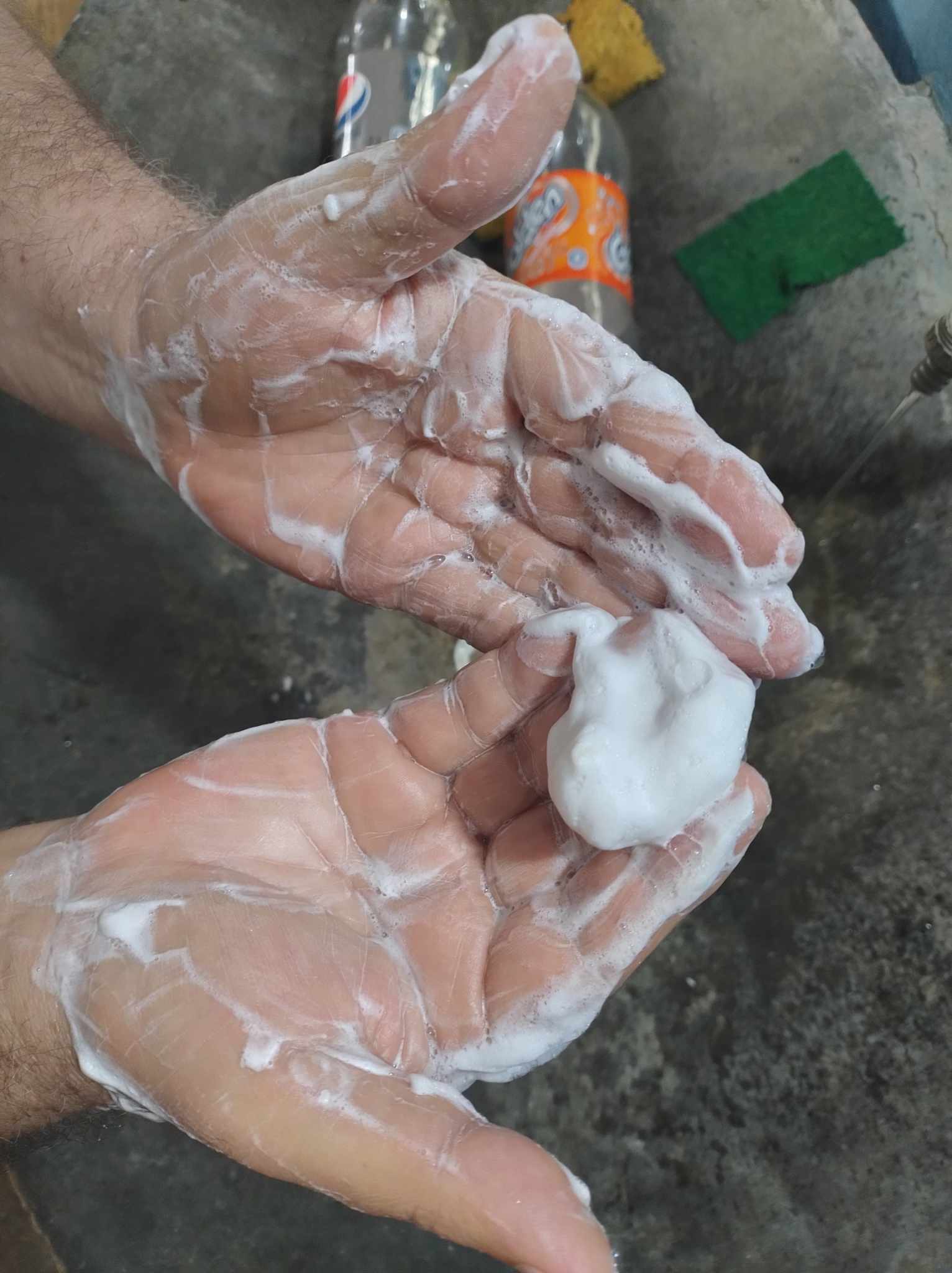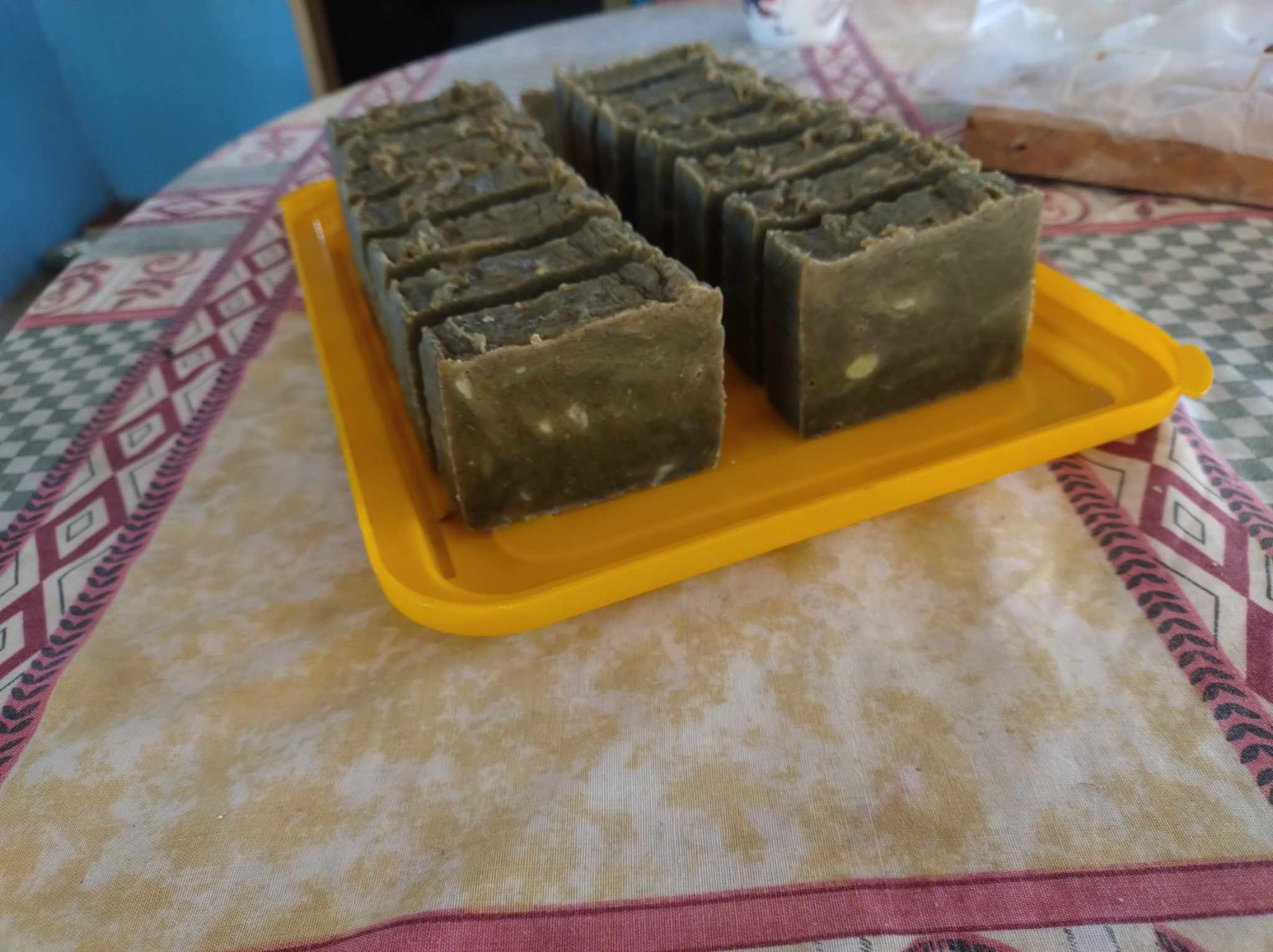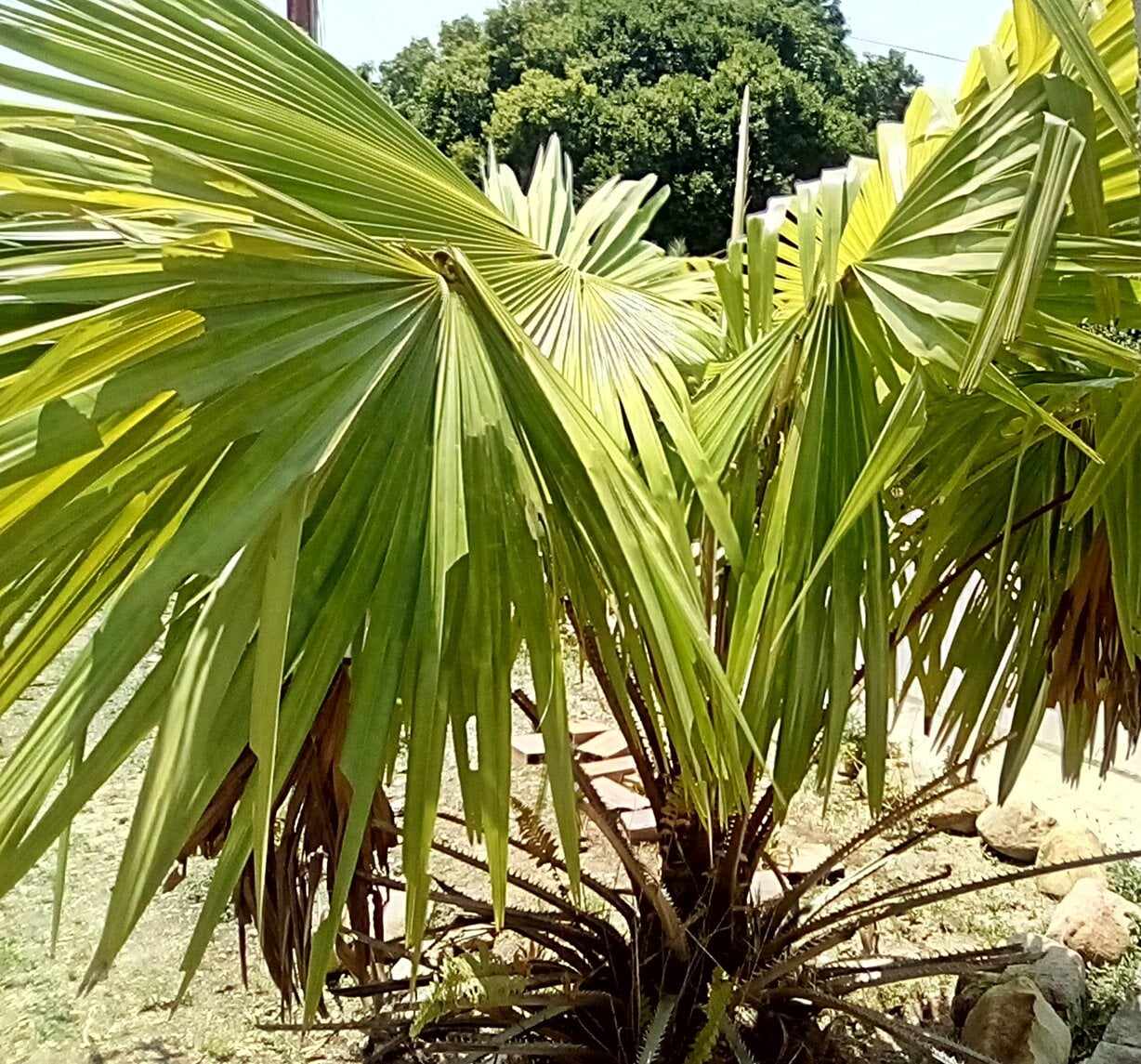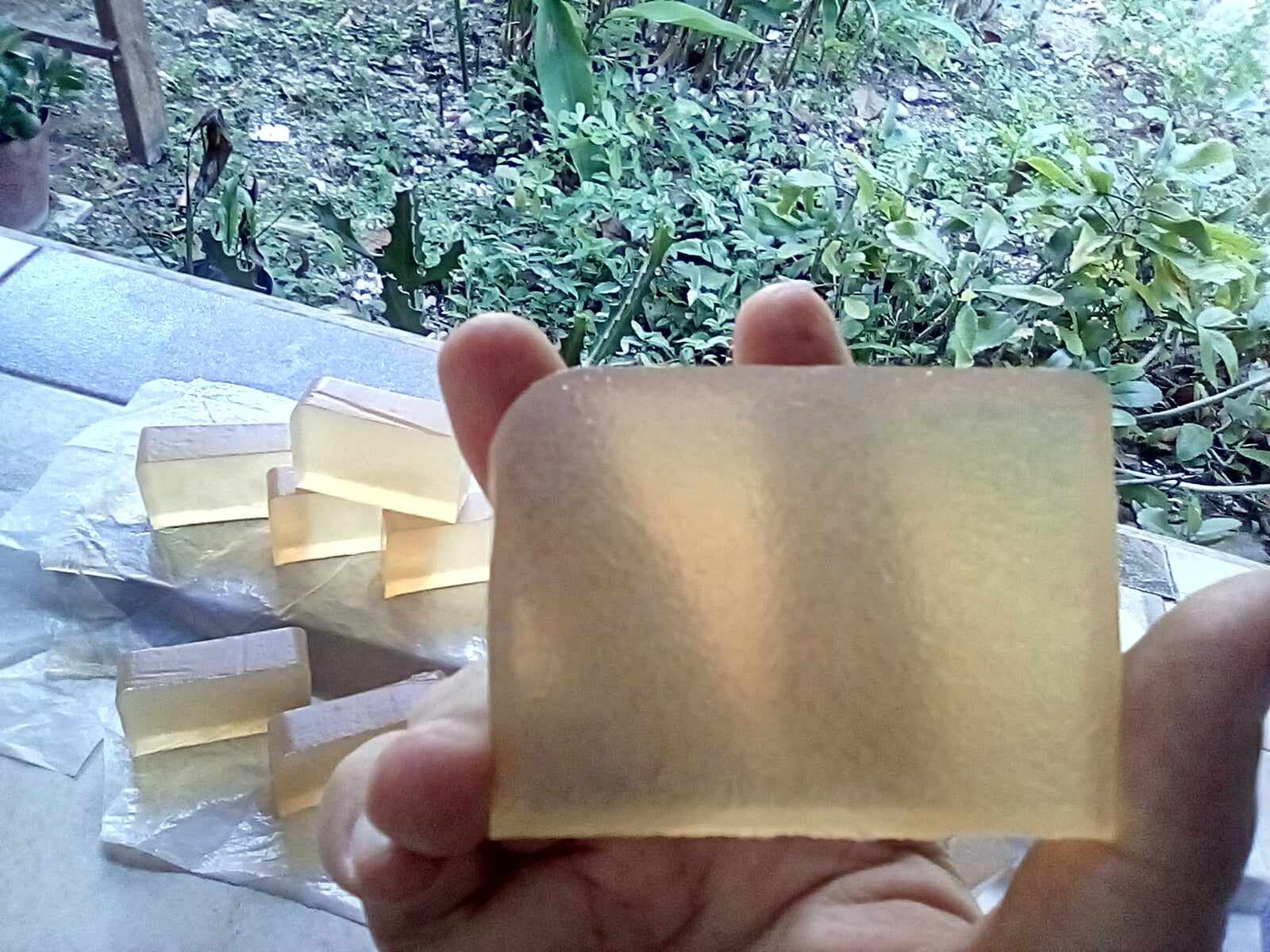
En estos días he vuelto a hacer varios jabones, incluyendo pequeñas variantes en su formulación, buscando mejores características.
La espuma en mis manos, que se siente con la persistencia de un jabón de afeitar, es gracias al aceite de ricino en combinación con el de coco y otros aditivos para evitar la resequedad por la excesiva limpieza. Un jabón ideal debe estar en equilibrio en sus características: Dureza, solubilidad, espuma, limpieza y acondicionado, pues queremos que dure, pero que haga mucha espuma con facilidad, y limpie, pero sin resecar la piel, lo que nos lleva a seleccionar los diferentes ingredientes y activos o aditivos.

Estas pastillas de verde intenso, las prepare para un cliente muy especial que quería un jabón natural que contuviera alguna planta que pueda encontrar en nuestro entorno, luego de conversarlo, elegimos la moringa, de cuyas hojas obtuvimos un extracto rico en vitaminas y minerales, además de un gel que aumenta el acondicionado y suavidad.
La participación del cliente resulto muy agradable y satisfactoria para ambas partes, espero que se repita este tipo de experiencia.

Hoy corte estas piezas que más parecen porciones de dulce. Un jabón de glicerina que perdió parte de la transparencia a causa del aceite mandarina, que le aporto una agradable fragancia, pero inevitablemente también lo opaca.
Quisiera hacer un jabón trasparente como un pedazo de vidrio, pero no sería un producto muy natural, se requiere de grasas refinadas que no contengan los elementos que le dan su color característico.
Suelen llamarlos jabón de aminas, por el empleo de aminoácidos refinados en lugar de los aceites y mantecas naturales. Por ejemplo, el aceite de palma, muy empleado en la industria del jabón y la alimentación, al extraerlo es de intenso color rojo y con un penetrante olor característico, por lo que antes de llegar al público pasa por diferentes y complicados procesos industriales, que en ocasiones denominan: RBD, refinado, blanqueado y desodorizado.

De una palma similar a esta se recogen unos grandes racimos con forma de piña de varios kilos, de los que se extraen dos diferentes aceites de la fruta, oleína y estearina y un tercero de la semilla, el palmistre, este último suele ser el ingrediente principal de los jabones comerciales, aunque en la etiqueta lo denominan: Kernalete, y cuando lean Tallowate, se trata del sebo de res.
Estos insumos y otros empleados por la industria no resultan muy accesibles a los artesanos, por lo que empleamos diferentes aceites como el del coco, el ricino, la oleína y la oliva, sin olvidar las mantecas vegetales, ceras un sin fin de productos saludables que en ocasiones son parte de la alimentación.

Hacer jabón implica estudiar un poco de muy diversas disciplinas; Química en primer lugar, algo de botánica, si quieres incorporar elementos naturales al jabón, la física y matemáticas son muy necesarias a la hora de manejar los volúmenes y densidades.
En mi caso me fue útil los rudimentos de carpintería para hacer los moldes y otros utensilios.
Las fotos fueron tomadas por mi, menos aquellas donde aparecen mis manos, esas las tomaron, mi hija o mi esposa, quienes siempre colaboran y participan en esta afición y emprendimiento.
Por cierto, el título de la publicación es el resultado de calcular la cantidad de jabón elaborado desde agosto de 2014 hasta ahora.
875 lotes de diferentes clases y tamaños, desde 800 gramos hasta 9 kilos. Estimo que unos 2.000 kilos de jabón, que resultarían en 24.000 pastillas de 80 gramos o más.
Aunque nos interesa más la variedad y la calidad que la cantidad.

24,000 soaps and more

These days I have made several soaps again, including small variations in their formulation, looking for better characteristics.
The foam on my hands, which feels with the persistence of a shaving soap, is thanks to the castor oil in combination with coconut oil and other additives to avoid dryness due to excessive cleaning. An ideal soap must be balanced in its characteristics: Hardness, solubility, foam, cleaning and conditioning, since we want it to last, but foam easily, and clean, but without drying the skin, which leads us to select the different ingredients and active ingredients or additives.

I prepared these intense green tablets for a very special client who wanted a natural soap that contained a plant that could be found in our environment. After discussing it, we chose moringa, from whose leaves we obtained an extract rich in vitamins and minerals, in addition of a gel that increases conditioning and softness.
The client's participation was very pleasant and satisfactory for both parties, I hope this type of experience is repeated.

Today I cut these pieces that look more like portions of candy. A glycerin soap that lost part of its transparency due to the mandarin oil, which gave it a pleasant fragrance, but inevitably also made it opaque.
I would like to make a transparent soap like a piece of glass, but it would not be a very natural product, it requires refined fats that do not contain the elements that give it its characteristic color.
They usually call them amine soap, due to the use of refined amino acids instead of natural oils and butters. For example, palm oil, widely used in the soap and food industry, when extracted, has an intense red color and a penetrating characteristic odor, so before reaching the public it goes through different and complicated industrial processes, which Sometimes called: RBD, refined, bleached and deodorized.

From a palm similar to this one, large pineapple-shaped clusters weighing several kilos are collected, from which two different oils are extracted from the fruit, olein and stearin, and a third from the seed, palm oil, the latter usually being the ingredient. main ingredient of commercial soaps, although on the label they call it: Kernalete, and when they read Tallowate, it is beef tallow.
These inputs and others used by the industry are not very accessible to artisans, so we use different oils such as coconut, castor, olein and olive, without forgetting vegetable butters, waxes, an endless number of healthy products that Sometimes they are part of the diet.

Making soap involves studying a little of very different disciplines; Chemistry first, some botany, if you want to incorporate natural elements into soap, physics and mathematics are very necessary when managing volumes and densities.
In my case, the rudiments of carpentry were useful for making molds and other utensils.
The photos were taken by me, except those where my hands appear, those were taken by my daughter or my wife, who always collaborate and participate in this hobby and undertaking.
By the way, the title of the post is the result of calculating the amount of soap made from August 2014 until now.
875 lots of different types and sizes, from 800 grams to 9 kilos. I estimate about 2,000 kilos of soap, which would result in 24,000 bars of 80 grams or more.
Although we are more interested in variety and quality than quantity.

